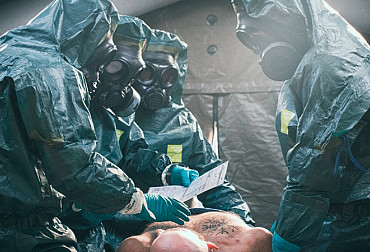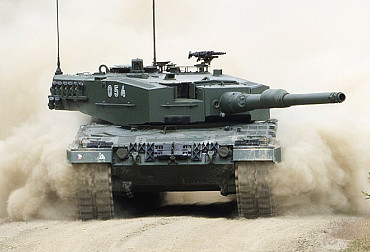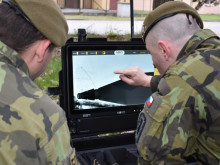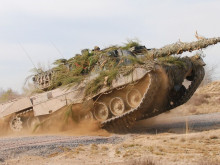The way to preserve the main capabilities of the Army of the Czech Republic
The Czech Army is in the middle of a modernisation process. Some acquisition projects have already been signed (CAESAR howitzers, Short and medium range anti-aircraft missile system), other significant acquisitions, which include for example the purchase of new Infantry Fighting Vehicles, need to be finished. These are, of course, relatively expensive items that will put a significant strain on the budget of the Ministry of Defence, which at the same time has to prepare itself for a certain reduction in resources as the Treasury needs to cope with the effects of the pandemic crisis. In this context, there is speculation that some of these major acquisition programmes could be postponed or stopped altogether, or that some of the relevant types of troops of the Czech Army could be substantially reduced or cancelled, which would, of course, undoubtedly have very serious consequences.
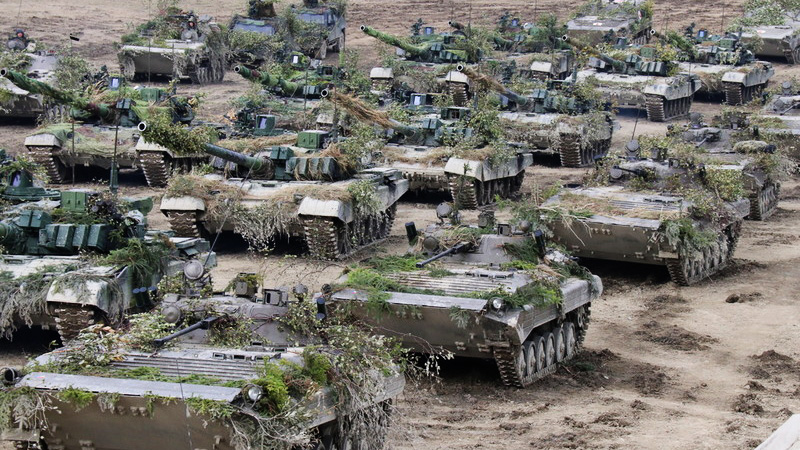 Picture: The Czech Army is in the middle of a modernisation process and still needs to complete several major acquisition projects, including the purchase of new Infantry Fighting Vehicles, self-propelled howitzers and anti-aircraft missile systems. (illustration photo) | Ministry of Defence of the Czech Republic
Picture: The Czech Army is in the middle of a modernisation process and still needs to complete several major acquisition projects, including the purchase of new Infantry Fighting Vehicles, self-propelled howitzers and anti-aircraft missile systems. (illustration photo) | Ministry of Defence of the Czech Republic
Virtually no relevant expert disputes that the Czech Army has suffered from significant and repeated budget cuts for many years, as its finances were usually the first to go when savings were needed. The result has been a huge internal debt, which has manifested itself mainly in the fatal obsolescence of many categories of equipment, most of which date back to the days of the previous regime and no longer meet the requirements of the current battlefield. This also applies to ground equipment, including Infantry Fighting Vehicles and artillery and anti-aircraft assets, and these categories were therefore included in the large-scale modernisation plans that were launched in the middle of the last decade in connection with the conflict in eastern Ukraine, among other things. Earlier assumptions of a low probability of a large-scale conventional conflict in Europe have proved to be wrong, and the same is true of the judgment that there would be a considerable period of warning or alert against such conflicts (roughly several years). At the same time, it became apparent that the era of large-scale foreign missions was coming to an end, so that priority was given to rebuilding all-military capabilities primarily for the defence of the home territory, the very thing that had been neglected.
In the past, it was assumed that the Czech Army would be forced (in the worst case scenario) to defend the Czech territory on its own for a few weeks at most, until allied reinforcements arrived. However, the situation suggests that these assumptions were probably unreasonably optimistic. The current Concept for the Build-up of the Army of the Czech Republic 2030 therefore calls for the ability to defend the Czech Republic independently for months, as it must realistically take into account the scenario that the allies will not be able or politically willing to adequately help us. Similar processes can also be observed in other Central and Eastern European countries, as the armies of Poland and Hungary in particular are carrying out very extensive acquisition programmes, which should bring them to a level quite comparable to that of the developed countries of Western Europe (perhaps even higher in the case of Poland, as the Poles are counting on a number of tanks greater than that of Germany and France combined). For the Czech Army, therefore, this logically implies a very strong appeal for the continuation of the modernisation process, or for the continuation of these large acquisition projects.
However, the effects of the pandemic crisis will of course not escape the budget of the Ministry of Defence either, so the possibility that sufficient funds will simply not be available for all programmes must also be taken into account. Therefore, there have been speculations that some of the projects could be suspended or cancelled altogether, or that some of the types of troops in the Czech Army could also be cancelled. However, such proposals must be warned against very strongly, as they could cause irreparable damage. Similar ideas have been floated in the past, but fortunately most of them have been prevented from taking place. Let us recall here, among other things, the theses from the end of the first decade of this century that the army could completely abandon tracked infantry fighting vehicles, ground-based air defence or attack helicopters. All of these items were nevertheless retained, but it should also be noted that the Czech Army abolished artillery rocket launcher units without replacement, which from today's perspective seems to be a serious mistake. Experience clearly shows that strengthening or expanding a maintained (albeit much reduced) capacity is always many times easier and cheaper than rebuilding a capacity that has been cancelled.
The Army of the Czech Republic must therefore necessarily maintain all important capabilities, or types of troops, because modern armed forces, which undoubtedly include and want to include, function as closely interconnected and integrated systems. The different types of troops are complementary, or complementary and mutually supportive, as each has unique capabilities. Tanks function as the primary source of destructive power and the means to break through enemy lines, but this breakthrough must be immediately exploited and augmented by mechanized infantry in armored vehicles. Long-range artillery destroys enemy targets and supports the advance of its own troops, while air defenses serve to protect against the effects of the enemy's air and missile capabilities. And of course, these are just the most basic types of troops, but each has an irreplaceable role to play because they fill certain roles that other types of troops cannot. For this reason, we also need to reject the political and media flossures of 'let's not buy tanks, let's buy drones'. After all, last year's conflict over Nagorno-Karabakh demonstrated not only the capabilities of drones, but also the need for synergy in the deployment of other types of troops, because although the Azerbaijani drones inflicted heavy losses on the Armenians, the territory was then occupied and controlled by tanks and mechanised infantry.
At the same time, however, the Czech Army will have to adapt to economic realities or will have to reckon with a reduced budget, which will undoubtedly also affect planned acquisitions. In any case, it would be a huge mistake to cancel any of the important projects, because then the "rock, paper, scissors" system would be seriously disturbed, i.e. the mutual irreplaceability of different types of troops. The BVP-2 Infantry Fighting Vehicles are beyond their useful life and need replacement badly. The same is true of the Kub anti-aircraft missile systems, and it is also clear that the army needs a modern artillery system of NATO standard with adequate range, because the DANA howitzer, although a quality design, is simply not up to current requirements. All three acquisition projects should therefore be completed, although some reduction of any of them is certainly conceivable. In this sense, the purchase of 210 Infantry Fighting Vehicles for a sum of about 52 billion crowns seems to be the most attractive, since the content of the acquisition does allow for some (temporary) reduction.
Let us recall that the Army of the Czech Republic currently requires a total of 210 armoured vehicles in seven different versions. Just over half of the number (exactly 125 units) is to be the basic version, or literally the Infantry Fighting Vehicle, while the rest is to be six specialised special-purpose versions. Specifically, these are the command, reconnaissance, artillery observation, medical, engineer and recovery vehicles. It should be noted that the cost of the tracked platforms themselves is likely to account for no more than half of the total amount, while half (or more) will be spent on special equipment for these special-purpose variants, support equipment (including 29 support vehicles), servicing, spare parts, etc. Therefore, it is also probably appropriate to consider a certain reduction of the programme, or a reduction in the number of examples of certain variants, which may concern both the basic combat version and the significantly more expensive specialised versions, which are to be procured in numbers ranging from 11 to 26 units. A certain reduction in the number of e.g. command, reconnaissance or engineer vehicles could therefore have a rather significant impact on the overall price. However, it is undoubtedly necessary to procure all of the intended variants, even in reduced numbers, as this will build the basis for both operational and training capabilities, which can then be expanded.
At this point, it is worth emphasising that deliveries and payments are spread over a relatively long period of time, as it is envisaged to take delivery of the vehicles between 2023 and 2027 and to make payments up to 2028. The economic and security situation of the Czech Republic will certainly change in the meantime. The total number of 210 armoured vehicles can thus be kept as a final number including the option, so that the Czech Army could now obligatorily purchase that reduced number of vehicles, while the additional units would be included in the option and could be purchased with a certain delay when the budgetary framework permits. This would not be exceptional, as it is quite common practice for armies to acquire military vehicles of a certain type repeatedly if the type in question proves its worth and if requirements for an increased number of units arise. After all, the Army of the Czech Republic initially requested up to 234 Pandur II vehicles (or 199 units with an option for another 35), but this was subsequently reduced to 107 units. However, 20 command and liaison armoured vehicles have now been added and there are considerations about the possible acquisition of other versions, e.g. mortars carriers. A similar approach could therefore be taken for tracked Infantry Fighting Vehicles.
In any case, we must once again strongly appeal for the continuation of the modernisation process, which addresses the long-standing problems of the Czech Army's equipment. This is not a matter of 'spending', but of investing in the security of the country and, indeed, in the domestic defence industry, which is to play a significant role in the implementation of all contracts. We must accept the fact that the world is becoming less and less secure and less predictable. The coronavirus pandemic proves that very serious threats to security can suddenly appear, which experts may even warn about repeatedly, but which most politicians, the media and the public do not pay attention to until it is too late. This is why threats of a military nature must not be underestimated, which logically leads to the need to constantly modernise the armed forces, because the army continues to represent one of the most important guarantees of real security, freedom and sovereignty of the state.















